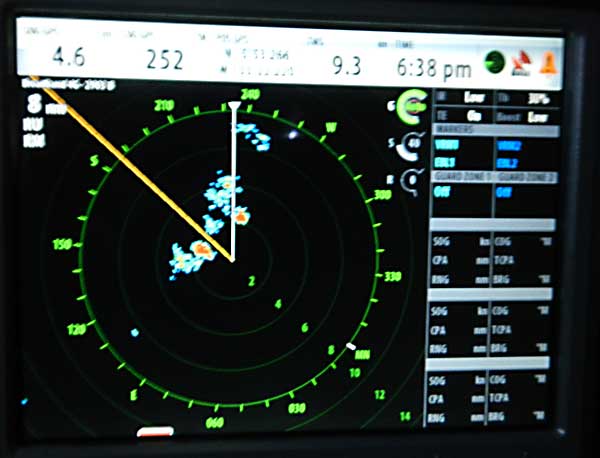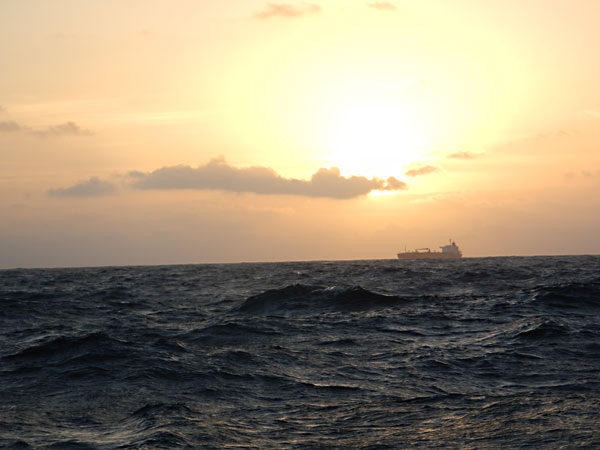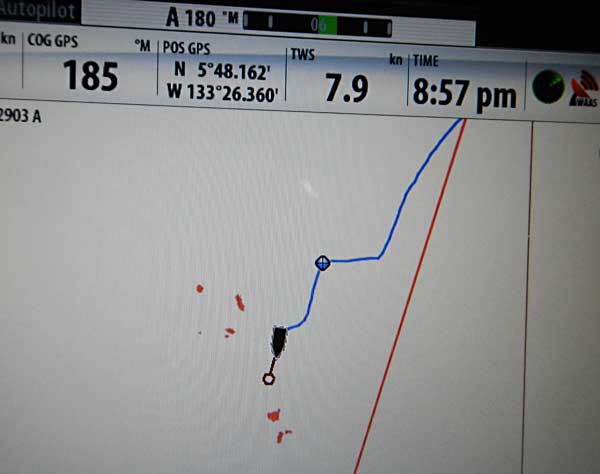We weren’t alone out there. For the first 10 days or so of the passage, we saw on average, two ships a day. There were a couple of days we saw up to four at once when we got further south, closer to Panama. After that, it was almost always one a day. Often, we’d only see them on radar or AIS (a kind of air traffic control transponder for boats). This one was about 2 miles away. We had a 982 foot tanker pass about a mile in front of us. It looked like an island complete with waves crashing on it’s side. While that tanker was the closest, we were in no danger. We’d talked with the captain on the radio to ensure a safe clearance. -Rich (May 2012)
Author: richwest3
Two Days Out (Passage to the Marquesas)
May, 2012
We’re trying to slow down a bit, which goes against our instincts. We need to slow down to try to make it to the east end of Hiva Oa at about 7AM on Friday. We want daylight for what should be a spectacular 20 mile ride to the bay where we’ll anchor. Along the way we should be treated to lush green volcanic peaks, some 3500 feet high. I can’t wait! I’m also sorry to see the passage coming to an end.
Last night was one of our most beautiful at-sea nights. I woke Cyndi to see an almost perfectly horizontal Cheshire grin of a moon setting with Venus right along side. The sky was filled with stars and so was the sea. The stars in the sea were from bio-luminescence, plankton that gives off light when disturbed. Normally, it’s millions of tiny, tiny lights that form a cloud of green glow. Last night it was fewer, larger, individual flashes. Sometimes there was what seemed to be a cluster that would light up Frisbee-sized disk of water off to the side or back of the boat. These flashes were intensely bright green. In the distance, small breaking waves would glow with bio-luminescence. There was a nice warm breeze – the temperature dropped enough to cool us down from the hot day. Our bellies were full of a great fish dinner.
We caught that fish the day before. It was a nice sized Mahi Mahi – maybe three and a half feet long. We have had fish for every meal since then. Last night it was grilled fish with canned green beans. This morning, it’ll be fish and eggs, again. We are really hoping to catch one more fish before we head into the anchorage. It’ll be nice to be able to prepare a few meals on a boat that isn’t rolling like a mechanical bull. Hey, wouldn’t that make a great cooking channel show? Iron Chefs on a Bull! “Stephanie, this will be difficult – he’ll prepare crepes while the bull is set at 9. I don’t think it’s been done before.” Alternatively, how about “Iron Chefs on a 38 Foot Boat.” I’d watch that.
OK, I see I’ve been at sea too long. That’ll change soon enough. -Rich
Not the Direct Route (Passage to the Marquesas)
Crossing the Equator! (Passage to the Marquesas)
May 20, 2012
Cyndi: As we approached the time of our equator crossing, it had become apparent that it would be a nighttime event, around 9 or 10pm, and I was feeling a little disappointed. All the pictures I have seen of other boats crossing have been taken during the day; so that’s just what I’ve always pictured. Even more concerning was that this would take place during Rich’s watch, at a time when I am asleep. He has been promising surprises, the kind of surprises that I might not enjoy. I knew that if this took place on my watch, while he’s asleep, then I could keep an eye on him, waking him up just before the event. But now it would happen during my sleep, leaving him lots of dangerous free time.
Rich: It’s kind of a tradition to torture people as they go across the equator on a boat for the first time. Before you cross, you’re a pollywog. After the crossing, and ensuing “hazing” ceremony, you’re a shellback. Cyndi and I were both pollywogs. I’d been across on a big ship a couple of times, but I ducked out of the ceremony saying something like, “me, oh no, I’ve been across the line lots of times!” I left the rubbing on of the blue goo (that I’m pretty sure included spoiled fish guts) to other suckers. It was our turn now.
Cyndi: I woke up about half an hour before we were to cross and got ready, putting on enough clothes so I could be in pictures and getting the rum out, a special bottle that friends gave us for this occasion (thanks Stacy and Ramiro!) Rich was in the galley, and I had mixed feelings when I spotted the surprise. Rich had taken 3 Oreos and topped them with spray cheese (that stuff in a can that squirts through a nozzle). That concoction is an old joke between us stemming from a previous passage where I woke to find Rich having this as a snack and thought he’d lost his mind. He thought it would be fitting for our crossing. I was relieved that this wasn’t a messy kind of surprise that would leave me needing a shower, but I was dreading that I might actually have to eat one of these things.
Rich: OK, so most the hazing turned out to be psychological torture. I’m sure Neptune would approve. And I’ve got to say, those cookies and “cheese” were really pretty bad. Much worse than my memory. Maybe I had gone a little round-the-bend on that previous passage when I thought they were a really neat idea.
Cyndi: We headed into the cockpit with the cookie things, three shots of rum (one for each of us and one for King Neptune) and our empty wine bottle with a note. We had a little time to sit and enjoy the night. It had a tropical feeling, with a warm, light breeze and a zillion stars in the sky above us. I realized that this was the perfect way for us to cross, much nicer than under the afternoon sun.
When the time came, we threw the bottle over, toasted our crossing and becoming Shellbacks, threw a shot of rum to King Neptune, then proceeded to sip our own rum. Wow, that rum was good; King Neptune should be really happy with us! I was really enjoying this, sipping excellent rum under a starry night sky, when Rich said we now have to eat the cookies. He threw one to poor King Neptune then had one himself. I took a nibble, avoiding the cheese, but I could still smell it and that smell did not go well with Oreos. Rich told me to have another bite, but I told him I distinctly heard King Neptune wishing he could have another and quickly threw it over. Thankfully Rich didn’t object. I figure if King Neptune gets a whole shot of that wonderful rum, he can take care of this cookie thing for me.
We lingered outside, finishing our drinks. I could have sat out there for hours, but we needed to run the engine and charge up the boat’s batteries, plus I needed to get some more sleep before my watch. In all, it turned out to be a really nice, mellow crossing.
Rich: This is the first I’m hearing about Cyndi avoiding the cheese topping. I think King Neptune might not be quite done with her after all. We shall see. By the way, the bottle had kind of the traditional “Dropped in the sea at position… by the crew of Legacy…” kind of note. We also included a little money as a gift for who ever might find it. It’s kind of fun for us to think about this bottle with it’s contained cash washing ashore in some small, poor village in South America, but I guess it’s just as likely to be picked up by a overweight, cigar-puffing, speedo-clad Malibu beach-walker and ultimately ending up stuffed in a strippers thong. Oh well, I’m sure she (or he) can use the cash.
Squalls (Passage to the Marquesas)

This is what our radar often looked like at night in the ITCZ. The blotches are squalls. They didn’t bring too much rain or wind but they meant that we couldn’t use automatic guard zone alarms to alert us of ships as the squalls would set off the alarm. We really had a pretty mild ITCZ crossing as we understand it – there is often a much larger area with squalls alternating with no wind. We made it through in about 36 hours. (May 2012)



